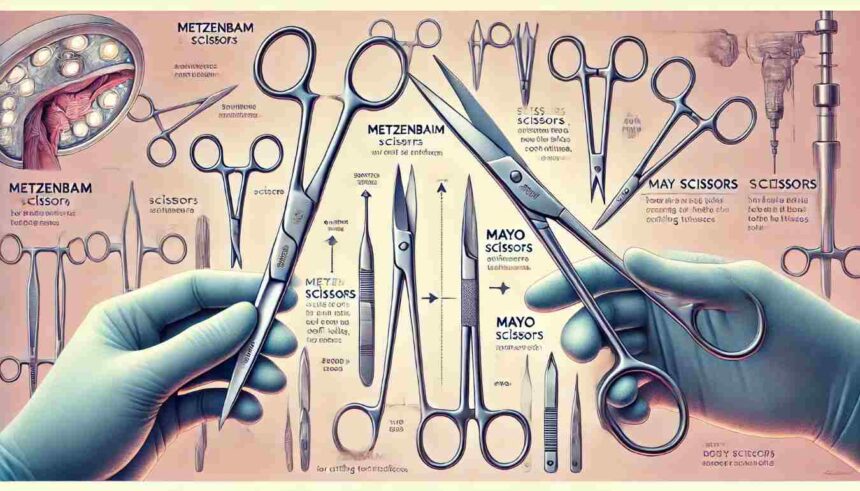Metzenbaum scissors and Mayo scissors are two commonly used surgical instruments that play vital roles in various types of surgery. These scissors are designed to perform different tasks, from cutting delicate tissues to tougher muscles and fascia.
What Are Metzenbaum Scissors?
Metzenbaum scissors, often referred to as “Metz” scissors, are specialized surgical scissors that are used to cut delicate and fine tissues. These scissors have a long, thin shaft and very fine blades, making them ideal for tasks that require precision. Surgeons frequently use Metzenbaum scissors in procedures where minimal damage to the surrounding tissues is critical.
For example, Metzenbaum scissors are used in surgeries involving the skin, muscle layers, fat, and fascia. The delicate nature of these scissors allows them to maneuver around sensitive tissues without causing unnecessary trauma.
One of the distinctive features of Metzenbaum scissors is their slim blades. They are usually available in straight or curved variations, and the curved blades offer better access to hard-to-reach areas during surgery. The scissors come in different sizes, with smaller ones used for fine tissue dissection and larger versions for cutting through slightly tougher tissues.
What Are Mayo Scissors?
Mayo scissors are another type of surgical scissors, but they differ significantly from Metzenbaum scissors in terms of their construction and purpose. These scissors have sturdier, thicker blades that are designed to cut through tougher tissues.
Mayo scissors are commonly used for cutting muscle, fascia, and even some tougher connective tissues during surgeries. While they can be used for delicate tissue dissection, their strength makes them more suitable for larger and firmer tissues.
Mayo scissors come in both straight and curved variations, similar to Metzenbaum scissors. The difference lies in the design of their blades. Mayo scissors have broader blades and a stronger build, allowing them to handle more resistant tissues without causing damage.
Surgeons use Mayo scissors in procedures where precision is important, but the tissues being cut are more resilient, such as in abdominal or orthopedic surgeries.
Key Differences Between Metzenbaum Scissors and Mayo Scissors
While both Metzenbaum and Mayo scissors serve similar functions, there are several critical differences that set them apart. These differences make each type of scissor better suited to specific surgical applications.
1. Blade Construction and Design
The most obvious difference between Metzenbaum scissors and Mayo scissors is the design of their blades.
Metzenbaum Scissors: The blades are thin and delicate, making them ideal for cutting fine and soft tissues. Their long and narrow shape helps reach into confined spaces during surgeries, offering greater precision and control. The blades are finely pointed or curved to allow the surgeon to dissect tissues carefully without causing damage.
Mayo Scissors: Mayo scissors have wider, thicker blades that are built to handle tougher, more rigid tissues. The design of the blades is stronger, and they are particularly suited for cutting through muscle, fascia, and connective tissues. The broad blades of Mayo scissors give them more strength to cut through dense materials.
2. Surgical Applications
Another significant difference is the type of tissues that each scissor is best suited for cutting.
Metzenbaum Scissors: These scissors are primarily used for cutting delicate and soft tissues. They are ideal for procedures where surgeons need to preserve the integrity of the surrounding structures while working with tissues like skin, fat, and superficial muscles.
Metzenbaum scissors are often used in general surgery, cardiovascular surgery, and plastic surgeries where precision is paramount. Mayo Scissors: Mayo scissors are intended for cutting tougher tissues that are harder to dissect.
They are commonly used for orthopedic surgeries, abdominal surgeries, and other procedures that involve deeper or firmer tissues. Mayo scissors are less suitable for delicate tissue dissection due to their broader, thicker blades, which can damage sensitive tissues.
3. Strength and Durability
Mayo scissors are stronger and more durable compared to Metzenbaum scissors due to their construction. Mayo scissors are designed to withstand the stress of cutting through tougher tissues without dulling or breaking. They are built to handle more resistance during surgery, and their thicker blades help maintain their strength over time.
On the other hand, Metzenbaum scissors are built for finesse. While they are incredibly sharp, they are not intended for the same level of durability as Mayo scissors. Metzenbaum scissors are more delicate and should be used with care to avoid damaging the blade or the handle during procedures.
4. Length and Handle Design
Metzenbaum scissors tend to be longer and slimmer than Mayo scissors. The longer length allows surgeons to access deeper or confined areas with ease, and the slim handle provides a better grip and more control over precise cuts.
Mayo scissors, however, come in shorter lengths and are typically heavier in construction. This shorter length gives the surgeon more control over cutting thicker tissues. The handles are generally broader to provide more leverage for cutting through dense material.
5. Variations and Types
Both types of scissors come in various sizes, but the types of variation differ.
Metzenbaum Scissors: Metzenbaum scissors are available in several different sizes, from very small scissors that are used for fine dissection of delicate tissues to slightly larger ones that are used for cutting through thicker tissues. They are often categorized by their size, with some designed for pediatric use and others for adult surgeries.
Mayo Scissors: Mayo scissors also come in different sizes, but their variation is primarily in the thickness and shape of the blades. Some Mayo scissors have heavier, stronger blades for tough tissues, while others have finer blades for cutting through smaller but tougher layers.
6. Ease of Use and Precision
Due to the delicate nature of Metzenbaum scissors, they allow for greater precision when cutting delicate tissues. Surgeons can use these scissors to carefully dissect soft tissues without risking injury to the surrounding areas. The fine blade design gives the surgeon greater control and allows for more precise movements.
Mayo scissors, on the other hand, are easier to use when cutting through tougher materials that require more force. They can handle a bit more pressure, making them less ideal for precision cutting but better suited for stronger tissues.
























